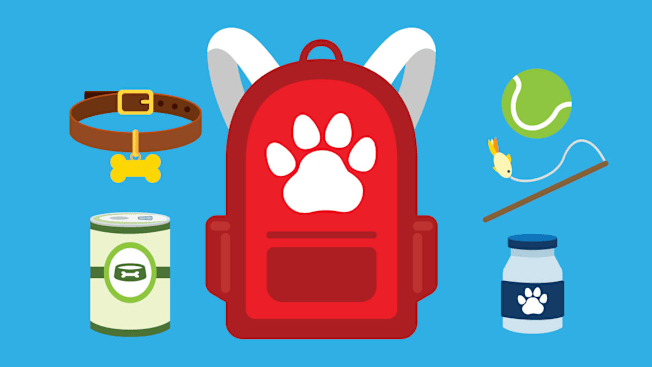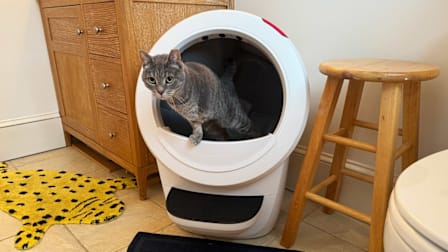How to Keep Your Pet Safe During a Natural Disaster
You should have a plan—and a go bag—for both yourself and your four-legged friends

Hurricanes, floods, and wildfires are disorienting enough for people, but pets can also lose their bearings when their home life is disrupted by a natural disaster. With some advance planning, you can better ensure not only your pet’s safety but also your entire family’s peace of mind.
Representatives from animal rescue organizations, including the ASPCA, Humane Society International, and American Veterinary Medical Association (AVMA) agree that the most important thing to do when you are alerted to a coming storm or advancing wildfire is to pay attention to official warnings, heed evacuation orders early, and take your pets with you even if you think you’ll be away only a short time.
- Preparing: Start in Advance Pack a Go Bag Look out for Wildfires
- During an Emergency: How to Find Shelter Locate a Lost Pet
- How to Settle Your Pet Back at Home
CR's Weather & Emergency Guide
Our expert advice and product reviews can guide you through the next storm.
Prepare in Advance
“Having a predetermined plan in case of a disaster will help you remain calm and think clearly in the event of an emergency,” says Mark Rosati, spokesman for the AVMA. “A plan gives you and your pets the best chance for a safe response to whatever disaster is threatening you.” Animal rescue groups recommend the following:
Get your pet microchipped. “One of the most important things you can do for your pet is to make sure it is microchipped and registered,” says Kelly Donithan, director of animal disaster response for Humane Society International. By scanning the chip on a found animal, a vet or shelter can identify its owner. You can have a microchip inserted by your veterinarian. If you’ve microchipped your pet but have changed addresses or phone numbers, correct the contact information.
Keep vaccinations up to date. Your pet’s shots should be kept current in any event, but this is especially important during a disaster when you may need a shelter. “Vaccination requirements can vary among emergency shelters and kennels, says Rosati. “Many pet shelters do require proof of up-to-date vaccination status to reduce the spread of disease. To maximize the chance that shelters will accept your pet, be sure to include proof of vaccination in your pet evacuation kit.”
Try a pet tracker. Consider a GPS pet tracker that works through an app on your smartphone. These small devices attach to your dog’s collar and typically use a combination of GPS and cellular signals to pinpoint your pet’s whereabouts in real time. While a microchip shows who a pet is, a tracker shows where it is. Consumer Reports evaluated seven pet trackers and compared their strengths and weaknesses.
Find emergency services. The Humane Society’s Donithan also recommends familiarizing yourself with the emergency services in your area, starting with your county’s disaster preparedness office and including local animal shelters and animal control officers. These are the folks you’ll need to call if you become separated from your pet. Keep the numbers handy by putting them in your phone contacts, along with the number of your vet.
Locate pet-friendly homes and hotels. If you live in a high-risk area, take time to investigate places that welcome pets before you actually need one. Check nearby hotels as well as those in areas along your evacuation route to identify which ones allow animals. And ask family and friends whether they’re willing to take in you and your pets in an emergency. Ask a trusted neighbor or friend to evacuate your pets in the event you are caught away from home during an emergency. Give them a key and make sure they know where to find your pet, as well as any supplies they may be need.
Put medical records in order. Organize your pet’s records and keep them in a safe place. Make copies to take with you in a waterproof folder or store them in the cloud or on a thumb drive (though that requires access to a computer). “It’s a good idea to keep medical records as far back as you have them, and to scan paper records and store them along with other digital medical information in an online folder, so you can access the records from wherever you are,” says AVMA’s Rosati.
If you’ve left your pet’s record behind in a hasty evacuation, your vet should still have your pet’s records on file. Typically, states require veterinarians to keep records for three to five years after the most recent examination or treatment, according to the AVMA.
Pack a Pet Go Bag
Prepare a go bag for your pet and keep it where you can easily grab it when you evacuate. If you live in a region that experiences frequent weather events such as hurricanes, it’s wise to assemble one at the beginning of the season (typically June for hurricanes) and keep it at the ready until the end of November. Here is what the ASPCA recommends to stock in a pet’s evac-pack. Medications should be rotated out every two months to ensure they don’t spoil or become ineffective.
- Collar with ID tag, contact number, and rabies tag.
- A traveling bag, crate, or sturdy carrier, ideally one for each pet.
- 7 to 10 days’ worth of canned (pop-top) or dry food.
- Bottled water, at least seven days’ worth for each person and pet.
- Pet feeding dishes.
- Extra harness and leash. (Harnesses are recommended for safety and security.)
- Two-week supply of any medicine your pet requires.
- Disposable litter trays (aluminum roasting pans are perfect).
- Litter and paper towels.
- Liquid dish soap and disinfectant.
- Disposable garbage bags for cleanup.
- Flashlight.
- Blanket (for scooping up a fearful pet).
- Recent photos of your pets (in case you’re separated and need to make "Lost" posters). Also include a photo of you and your pet together to document ownership.
- Your pet’s favorite toy, treats, and bedding.
Wildfire Smoke and Pets
While the recommendations above were developed to prepare for hurricanes and other severe storms, they apply to wildfires, too, which have become more frequent in recent years. Because wildfires advance so quickly, they can leave little time to prepare.
“As we’ve seen in the case of recent wildfires, emergencies can develop rapidly and unexpectedly,” says Rosati. “This is why having an emergency preparedness kit—including evacuation plans that include contingencies for your pets—is so important.”
An important first step is to sign up for local and state disaster and weather alerts. If you are far enough from the fire, you may not have to evacuate. But keep in mind that if you can feel the effects of smoke, your pet can, too. Keep your pet inside as much as possible—with the windows closed—and call your vet if you see signs of respiratory distress, such as wheezing, coughing, runny eyes or nose, or any other behavior out of the ordinary.
(See our review of the best air purifiers for wildfire smoke and how to monitor air quality to stay safe from health risks.)
Finding a Pet-Friendly Shelter
Once you’ve evacuated, your first concern will be finding a shelter that takes you and your pet. Donithan recommends starting with an emergency operations center that’s been set up to offer services to the displaced. Typically, these centers have animal rescue personnel provided by the ASPCA, Humane Society, and related groups. “We coordinate ahead of time, so we can move swiftly,” she says.
The Red Cross often operates emergency shelters, and in recent years it has loosened its no-pets policy. While not every Red Cross facility accepts pets, many now do. “The change in the Red Cross rules has been a huge help,” says Donithan. Find a Red Cross shelter.
Veterinarians are also part of the response. Depending on the need, there may be pop-up vet clinics and volunteer vets from the surrounding area and nearby states. “Veterinarians and other veterinary professionals volunteering with the National Veterinary Response Team may be deployed to the area to help injured or ill pets,” Rosati says.
Finding a vet can be more difficult if you are far from home. “Every situation and every disaster is unique. If an owner has to relocate to a different state, for example, they could check with that state’s Veterinary Medical Association for referrals, or do an online search for nearby veterinarians, as long as there is service available,” says Rosati.
Locating a Lost Pet
Despite an owner’s best intentions, pets can still get lost in all the chaos. If yours does, ask the personnel at the emergency operations center where to turn for help. Start with a local animal shelter and animal control, keeping in mind that if your evacuation route took you far from home, it may not be the one you identified originally.
Although they can be hit and miss, Facebook groups often spring up during the aftermath of a storm and can be helpful in locating a missing pet. That’s why it’s important to have a photo of your furry friend.
Donithan said that her group and others train technical responders to rescue stranded pets. They are trained to handle frightened animals as well as how to determine who they belong to and how to contact the owner. Volunteers don’t always have these skills. “An official response is best,” she says.
Settling Your Pet Back at Home
Even though it may seem like a joyful moment, taking a pet back home after an emergency evacuation has its own stresses. Not only has their routine been disrupted, but once-familiar surroundings may look and smell different, which can be disorienting.
Before taking your pet back home, inspect it for any injuries and call your vet if you see anything concerning. Even if you administered first aid, you should plan a visit to the doctor as soon as you can.
Before entering your home or yard, inspect it for sharp objects, contaminated water, or other hazards. Once you feel it’s safe, release your pet indoors only, even if it usually goes outside. Your pet will likely be exhausted, so let it sleep. For more tips on keeping your pet safe, visit the AVMA website.




















